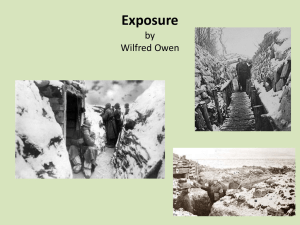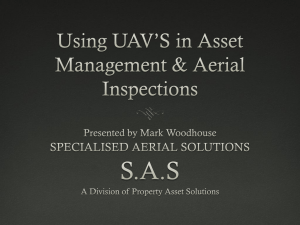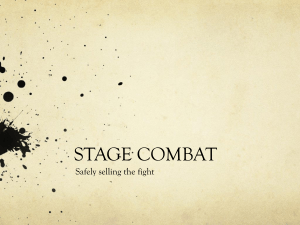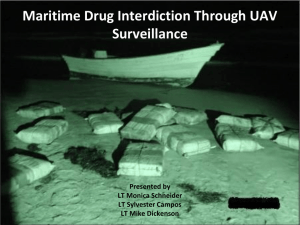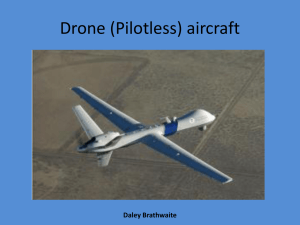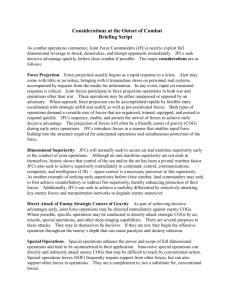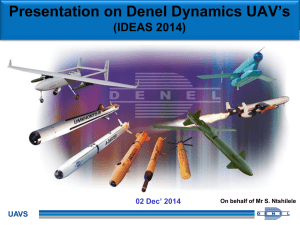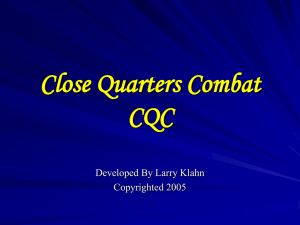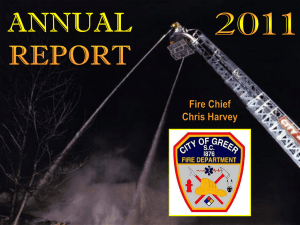Future Combat System - Transforming Logistics Through
advertisement
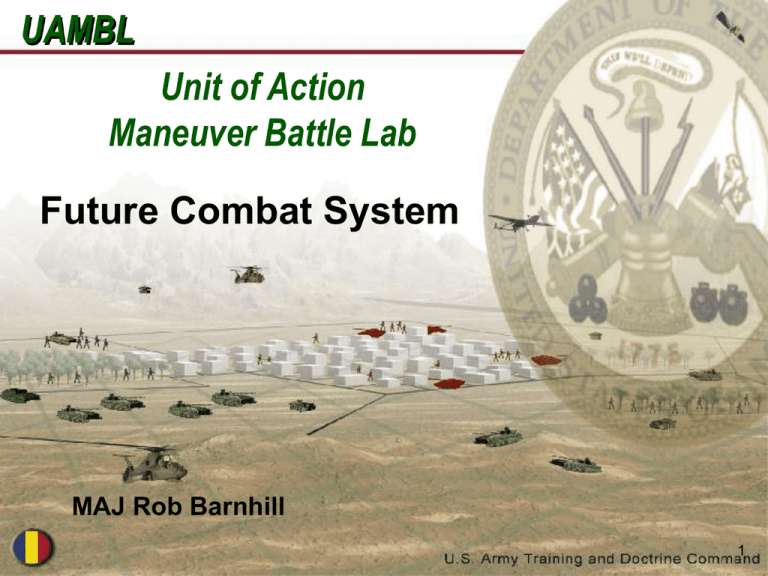
UAMBL Unit of Action Maneuver Battle Lab Future Combat System MAJ Rob Barnhill 1 Purpose To provide an Information Briefing on the Future Combat System, the Unit of Action design and the concepts by which we will fight these new systems. Agenda • Future Operational Environment • UA Characteristics and Capabilities • UA Design and Structure • Quality of Firsts • UA Battlespace • What makes this Force Different Operational Environment Doctrine Tactics • Access Denial - encompasses • Hide, Blind, Disperse, Decoy, Hug strategic preclusion, operational exclusion and access limitation • Protect assets from detection • System Warfare - critical links, nodes, seams and vulnerabilities to level the playing field. • Use complex terrain to degrade intelligence and reconnaissance • Trade space & bodies for time • Oppose access & movement (in • Opportunistic - primarily defensive CONUS to arrival) in nature (regionally), but allowing • Force us to occupy large areas for offensive maneuver during • Combined attrition with periods of opportunity. information warfare • Strategic Attack - direct effect on • Synchronize attacks to maximize American national will, leadership stress on US forces and strategy. • Use media events to advantage Future Force Characteristics III SOF Responsive: Embodies time, distance, and sustained momentum X Airborne X Light X SBCT III ACR X Mech Inf X Armor X Air Assault Deployable: Truly responsive forces must be deployable and capable of quickly and rapidly concentrating combat power in an Operational Area. Agile: Mental and physical agility to transition among the various types of operations. Versatile: Inherent capacity of Future Force formations to dominate at any point of the Spectrum of Military Operations. Lethal: When Future Force deploys, every element in the Warfighting formation is capable of generating combat power contributing to the fight. Survivable: Objective Force takes advantage of technologies that provide maximum protection of the soldier level on or off the platforms. Sustainable: Reduce logistics footprint and replenishment demand. UA Required Capabilities • Transportable by C130-like aircraft • UA deploy in 96 Hours—with ability to Fight on Arrival • Battle Command on the Move • C4ISR (Battle Command) Network • Networked Army and Joint Fires UA • Overmatch in all Conditions/Environments • Soldiers and Platforms Leverage Active and Passive Force Protection Systems • Reduced Sustainment Requirements and Logistic Footprint • Tactical and Operational Mobility CLOSE WITH AND DESTROY ENEMY FORCES TO SEIZE TERRAIN AND DOMINATE THE BATTLEFIELD Unit of Action Design UA 2550 V HHC BIC 110 91 190 3 x 572 HHC RECON 88 62 MCS INF 34 2 x 37 2 x 157 NLOS FSB 177 266 Family of Future Combat Systems • Soldiers remain the centerpiece of FCS • More important than machines; soldiers win wars, not machines. • The Soldier is a platform • Tied into the Network • Unmanned technology enhances operations • Armed with increased situational awareness • Knowledge based Battle Command • Physically and psychologically prepared for non-contiguous warfare • Full spectrum live and virtual training in multi-disciplined skills Family of Future Combat Systems Infantry Carrier Vehicle Unmanned Air Platforms Tube-launched Class III UAV Small UAV Combat Robots RAH-66 Comanche Class I and II UAVs) ClassTUAV IV UAV Soldier Robots MCS - BLOS/LOS Reconnaissance and Surveillance NLOS Cannon C2V Armed Reconnaissance Mortar Medical Treatment / Evac ICV NLOS Launch Systems Conceptual Framework ENTRY OPERATIONS ACTIONS BEFORE FORCES ARE JOINED • • • • Develops Situation out of contact Decides When / Where to fight Sets conditions Maneuvers to position of advantage SEE FIRST UNDERSTAND FIRST ACT FIRST FINISH DECISIVELY ACTIONS DURING CONTACT • Initiates decisive combat at chosen time/place • Continues to develop the situation in contact • Continues to integrate RSTA, maneuver, fires, and the network TACTICAL ASSAULT • Notion of close combat has expanded, but still must retain capability to close with and destroy the enemy through assault TRANSITIONS Transition to next engagement See First See the parts: • Detect • Identify • Track See the Whole: • Aggregate • Fuse See Environment: • Terrain • Weather • Population Key Enablers: • Combat Identification • Reconnaissance • Organic sensors (robotic, multispectral and disposable) • UAV • Embedded platform C4ISR • Sensor fusion • Global Information Grid • Joint C4ISR network • Leader training • Real-time mapping • Inter-agency coordination Force enemy to see last. Blind him through obscurants, deception, jamming, Pattern avoidance, signature reduction and counter-sensor operations. Understand First See the pattern: • Concept of operations • Scheme of maneuver • Centers of gravity • Decisive points • Vulnerabilities See the next several moves: • Enemy intent • Where he will go • ID likely methods • Action/reaction/counteraction Key Enablers: • Pattern analysis & recognition • • • • • Experienced based judgment Knowledge focused On demand collaboration Layered, redundant sensors Reconnaissance by action to compel a response • Force enemy to reveal intent Force enemy to understand last by employing deception, pattern Avoidancce and usage of irregular battlefield geometry Act First Platform: • Acquire • Shoot • Move • Reengage Unit: • Determine options • Decide first • Act to force reaction • Synch fires and maneuver • Establish area of influence • Shape, synch, and then transition to assault Key Enablers: • Situational awareness of red/blue • Embedded organizational C4ISR • Enhanced clearance of fires • Sensor-decided-shooter links • Advanced weapons control • Enhanced communications • Battle Command Network • Intent centric not plan centric • GIG and Joint reach capability • In stride obstacle/mine detection • Organic LOS, BLOS and NLOS • Enhanced survivability • UE, Army and Joint fires Force enemy to act last or wrong. Deny enemy action by deception, remotely emplacing obstacles, preemptive and immediate counterfire. Jam his computers, automation and weapons control equipment Finish Decisively Finish by: • Destroy enemy ability to fight • Eliminate freedom of action • Exploit success • Conduct close combat • Transition to assault • Follow through to enemy destruction Key Enablers: • • • • • • • • • • • • • • No tactical pause • Focus on “Profitable Fight” • Block moves to sanctuary Tactical overmatch Organic LOS/BLOS/NLOS fires Organic non-lethal fires Situational Awareness of Red and Blue Global information grid and Joint C4ISR network Scaleable integrated Joint fires and effects Capable of independent action Vertical maneuver All forms of Offense - Exploitation - Pursuit Sustainment for 3 days high optempo Campaign qualities Mobility Assault: Mounted, Dismounted, Mounted sptd by Dismounted, Dismounted sptd by Mounted • Mission staging of maneuver sustainment • Disrupt communications • Remotely placed obstacles • Logistics efficiency Integrated Concepts Joint Interoperability Information Assurance Situational Awareness Common Operating Picture Battle Command on the Move Information Fusion A2C2 Combat Identification Communications/Info System Distributive Information Database Sensor Fusion Surveillance and Recon Layered Sensors UAV Echelons Air Assault Unmanned Ground Vehicles Air/Ground Integration Manned/Unmanned Teaming Networked Fires BLOS Mutual Support Cooperative Engagement Point and Shoot Non-Lethal Effects Air and Missile Defense Assured Mobility Survivability CBRN Transportability Sustainability/Reliability Sustainment Distribution Maneuver Sustainment Medical Battlespace by Echelon Area of Influence: A geographical area in which a commander can directly influence operations by maneuver or fire support system normally under the commander’s command or control. Areas of influence surround and include the associated AO. Area of Influence Approximate Area of Interest Plt 8 km r 16 km r Co 16 km r 30 km r Bn 30 km r 75 km r Bde 75 km r 150 km r Deployment Alert Ports of Embarkation Marshall Move to POE Air Movement Sea Movement Entry Operations Decisive Operations CONUS SEALIFT PREP O ENROUTE REHEARSAL AND MISSION PLANNING Sustain Theater CINC Time AO X CBT TSC Ports of Debarkation • Minimal prep time required from alert to deploy • More deployable with reduced tonnage • Insert into austere theater through multiple unimproved entry points without relying on fixed ports and staging bases • UA deploys anywhere in the world in 96 hours after liftoff, a warfighting division on the ground in 120 hours, and five divisions in theater in 30 days • Deploy by air, ground or sea in support of early and forcible entry operations • Immediately employ using vertical and horizontal maneuver without undergoing reception and staging • Self-sustain operations for 3 to 7 days upon arrival. UA sustained by UE2 Support Force BE DECISIVE EARLIER Joint Interoperability ISR Aircraft OBJ GOLD SPOD MARFOR UA ARFOR (UE) UA ARFOR (UE) Coalition Forces BCT EECP JTF HQ Integrated Network C4ISR Enablers U2R ACS RJ UE ACS •SIGINT •IMINT •MASINT •HUMINT JSTARS •Counterintelligence Knowledge Centers DCGS-A UA (X) UA (X) CA Bn CA Bn HUMINT UA Co UA Home Sta. Support Node UA Co Robotics UA Co CIA CI UA Co Robotics Robotics Robotics Enables • • Rapid, Leader-Centric Tactical Decisions Independent, Combined Arms Maneuver ▪ Real-Time Common Operating Picture ▪ Actionable Information at Lowest Level Layered Sensors ACS U2R COP via the DIDb Comanche Class III UAV Class IV Class II UAV Class I UAV UGS ARV UAV Capability Chart System Echelon Opn’l Radius On Station Time Operating Altitude Allocation UAV (CL I) Plt-Co (54 Units) 8 km (T) 16 km (O) 50 min (T) 90 min (O) UAV (CL II) Plt-Bn (36 Units) 16 km (T) 30 km (O) 2 hours (T) 5 hours (O) 1,000 ft AGL 11,000 ft MSL 3 x INF Co 1 x MCS Plt UAV (CL III) Bn (12 Units) 40 km (O) 6 hours (O) 2,000 ft AGL 12,000 ft MSL 3 x Recon Co 3 x NLOS Bn UAV (CL IV) Bde (8 Systems) 75 km (T) 400 km (O) 5 hours (O) 12 hours (T) 6,500 ft AGL 16,500 ft MSL 8 x AVN Bn 500 ft AGL 10,500 ft MSL 1 x INF Plt 3 x Recon Plt 1 x NLOS Plt 1 x FSB Co Battle Command on the Move 3 CBT 3-5 km • Battle Command with actionable information Class IV UAV • Unprecedented opportunity to understand enemy and environment • Collaborative planning and virtual rehearsals on the move BCOTM Class II UAV 2 CBT BCOTM 3 CBT 4-6 km Class II UAV 2 CBT Sensor to shooter Networked Fires 1. Comanche identifies enemy systems; transmits sensor data through networked fires application Class III UAV confirms BDA: TARGETS DESTROYED FIRE MISSION ACCEPTED 2. Network determines shooter and transmits firing data to NLOS systems; establishes sensor to shooter link FIRE MISSION ACCEPTED 3. Common Operational picture instantaneously disseminates enemy location to all Blue systems. Survivability • Protect the individual soldier from ballistic, flame, thermal, Chemical/Biological, and electromagnetic effects • Active and Passive ballistic protection systems • Long-range acquisition with assured first round kill • Highly responsive suppression and obscuration fires • Signature management degrades detection and targeting • Superior dash speed from cover to cover • ‘Avenge’ kill capability • Embedded standoff sensor/detector for CBRN hazards • Counter-reconnaissance effort to blind enemy ISR • Hardened from Directed Energy weapons • Employ multi-purpose robots to perform manpower intensive and high-risk functions • Standoff means to detect and neutralize mines, demolitions and booby traps Non-Lethal Effects Non-lethal effects minimize mass physical destruction of people, materiel, infrastructure, and the environment, thus effectively enhancing friendly maneuver operations. NonLethal effects are delivered by LOS, BLOS, and NLOS; manned/unmanned systems. The use of non-lethal capabilities provides leaders a means to influence the actions of enemies and civilians/other non-combatants when minimizing collateral damage and undesired casualties. Incapacitate, suppress, disperse or engage personnel, places Deny vehicles and personnel access to, use of, or movement through a particular area/point Alter terrain/environmental conditions to favor “blue” Influence actions of others Separate combatants and non-combatants Bottom Line • FCS is the Army’s future full spectrum force • Not just a “more better” tank • New doctrine and tactics enabled by technology • Revolutionary increases in application of information • Combat units will: conduct simultaneous distributed operations develop situation out of contact maneuver to positions of advantage engage enemy beyond range of their weapon destroy him with precision fires at the times and place of our choosing Questions? MAJ Rob Barnhill Unit of Action Battle Lab Fort Knox, KY 40121 (502) 624-1733 Robert.Barnhill@knox.army.mil RAH-66 Comanche
